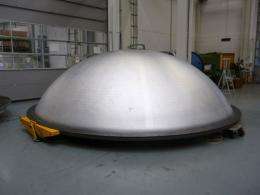NASA Spins Manufacturing Technology to Forge New Tank Hardware

Five years ago a group of engineers at NASA's Marshall Space Flight Center in Huntsville, Ala., and Langley Research Center in Hampton, Va., had the bold idea to manufacture a five-meter diameter fuel tank entirely out of aluminum lithium 2195 alloy, using advanced manufacturing methods that included friction stir welded joints and single-piece spun formed domes.
Why is this idea such a manufacturing advancement in how tank domes are produced today? This technology incorporates lighter weight material, significantly reduces the number of pieces needed to create a tank dome, eliminates numerous complex welding, machining and inspection steps and can be used on any large liquid propellant tank with greater reliability and lower costs.
To manufacture a typical dome using aluminum alloy 2219 requires eight gore panels, or pie shaped pieces, 10 welding steps, and multiple operations and inspections to assemble these pieces into a full-scale tank dome. The new manufacturing method takes two commercial off-the-shelf aluminum lithium 2195 plates that are joined using friction stir welding to produce a sufficiently large starting blank. The welded plate blank is then spun formed to create the single-piece tank dome.
This novel manufacturing approach also allows engineers and technicians to use the lighter-weight, higher-strength alloy aluminum lithium 2195 compared to current tank designs that use the heavier, lower-strength aluminum 2219 alloy. This could reduce the weight of future liquid propellant tank domes by 25 percent, both through the material replacement and the reduction in the number of welds.
NASA's Marshall Space Flight Center and Langley Research Center partnered with Lockheed Martin Space Systems in Denver, Colo., and MT Aerospace in Augsburg, Germany, to push the envelope in dome manufacturing by making use of existing commercial materials and cutting edge technology. This international partnership demonstrates the agency's desire to tap into rich sources of innovation to help address technical challenges that will mutually benefit NASA and next-generation space exploration.
Engineers at Langley and Marshall are currently evaluating samples of the successfully manufactured tank dome to ensure the strength and reliability of these novel tank forming processes. Each step brings them closer to their vision of creating an entire tank out of 2195 aluminum lithium.
One additional full-scale development tank dome is scheduled for manufacture and testing in the coming months as part of the joint, four-year technology demonstration program.
NASA has invested in the Friction Stir Weld Spun Form Dome Project since 2005.
Provided by JPL/NASA


















